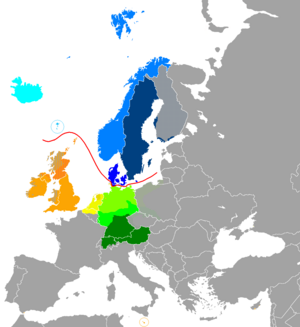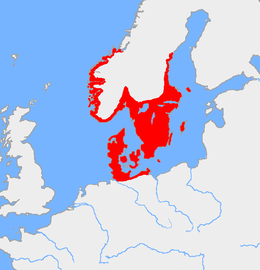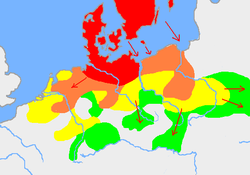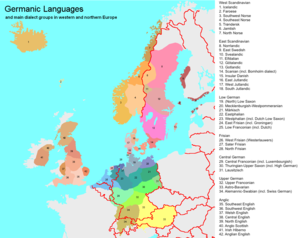Germanic languages
Proto-Germanic, along with all of its descendants, notably has a number of unique linguistic features, most famously the consonant change known as "Grimm's law."
English is an official language of Belize, Canada, Nigeria, Falkland Islands, Saint Helena, Malta, New Zealand, Ireland, South Africa, Philippines, Jamaica, Dominica, Guyana, Trinidad and Tobago, American Samoa, Palau, St. Lucia, Grenada, Barbados, St. Vincent and the Grenadines, Puerto Rico, Guam, Hong Kong, Singapore, Pakistan, India, Papua New Guinea, Namibia, Vanuatu, the Solomon Islands and former British colonies in Asia, Africa and Oceania.
German is a language of Austria, Belgium, Germany, Liechtenstein, Luxembourg and Switzerland; it also has regional status in Italy, Poland, Namibia and Denmark.
A group of Alemannic German dialects commonly referred to as Alsatian[17][18] is spoken in Alsace, part of modern France.
Dutch is an official language of Aruba, Belgium, Curaçao, the Netherlands, Sint Maarten, and Suriname.
Low German is a collection of very diverse dialects spoken in the northeast of the Netherlands and northern Germany.
[22] Frisian is spoken among half a million people who live on the southern fringes of the North Sea in the Netherlands and Germany.
Luxembourgish is a Moselle Franconian dialect that is spoken mainly in the Grand Duchy of Luxembourg, where it is considered to be an official language.
[23] Similar varieties of Moselle Franconian are spoken in small parts of Belgium, France, and Germany.
Proto-Germanic itself was likely spoken after c. 500 BC,[41] and Proto-Norse from the 2nd century AD and later is still quite close to reconstructed Proto-Germanic, but other common innovations separating Germanic from Proto-Indo-European suggest a common history of pre-Proto-Germanic speakers throughout the Nordic Bronze Age.
The earliest period of Elder Futhark (2nd to 4th centuries) predates the division in regional script variants, and linguistically essentially still reflects the Common Germanic stage.
By early modern times, the span had extended into considerable differences, ranging from Highest Alemannic in the South to Northern Low Saxon in the North, and, although both extremes are considered German, they are hardly mutually intelligible.
Some, such as Icelandic and, to a lesser extent, German, have preserved much of the complex inflectional morphology inherited from Proto-Germanic (and in turn from Proto-Indo-European).
Proto-Germanic had no front rounded vowels, but all Germanic languages except for Gothic subsequently developed them through the process of i-umlaut.
This ultimately resulted in some languages (like Modern English) losing practically all vowels following the main stress and the consequent rise of a very large number of monosyllabic words.
The following table shows the main outcomes of Proto-Germanic vowels and consonants in the various older languages.
Notes: The oldest Germanic languages have the typical complex inflected morphology of old Indo-European languages, with four or five noun cases; verbs marked for person, number, tense and mood; multiple noun and verb classes; few or no articles; and rather free word order.
In three months, the house will still be being built or If you had not acted so stupidly, we would never have been caught) is almost entirely due to subsequent developments (although paralleled in many of the other Germanic languages).
Note that most modern Germanic languages have lost most of the inherited inflectional morphology as a result of the steady attrition of unstressed endings triggered by the strong initial stress.
(Contrast, for example, the Balto-Slavic languages, which have largely kept the Indo-European pitch accent and consequently preserved much of the inherited morphology.)
Icelandic and to a lesser extent modern German best preserve the Proto–Germanic inflectional system, with four noun cases, three genders, and well-marked verbs.
In the 19th century, the two types of adjectives – indefinite and definite – were respectively termed "strong" and "weak", names which are still commonly used.
Furthermore, due to regular sound change, the various definite (n-stem) adjective endings coalesced to the point where only two endings (-e and -en) remain in modern German to express the sixteen possible inflectional categories of the language (masculine/feminine/neuter/plural crossed with nominative/accusative/dative/genitive – modern German merges all genders in the plural).
(This view is enhanced by the fact that modern German largely uses weak-ending adjectives when accompanying an indefinite article, and hence the indefinite/definite distinction no longer clearly applies.)
Although it is possible to group the various noun declensions into three basic categories — vowel-stem, n-stem, and other-consonant-stem (a.k.a.
It is only in Middle Dutch and modern German that the various vowel-stem nouns have merged to the point that a binary strong/weak distinction clearly applies.
As a result, newer grammatical descriptions of the Germanic languages often avoid the terms "strong" and "weak" except in conjunction with German itself, preferring instead to use the terms "indefinite" and "definite" for adjectives and to distinguish nouns by their actual stem class.
Note that divisions between and among subfamilies of Germanic are rarely precisely defined; most form continuous clines, with adjacent varieties being mutually intelligible and more separated ones not.
Early runic inscriptions also are largely limited to personal names and difficult to interpret.

North Germanic languages West Germanic languages Dots indicate areas where it is common for native non-Germanic speakers to also speak a neighbouring Germanic language, lines indicate areas where it is common for native Germanic speakers to also speak a non-Germanic or other neighbouring Germanic language.





• Early Middle Ages
• Early Twentieth Century